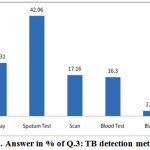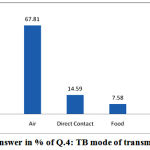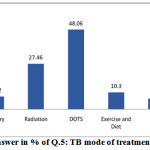Swarupananda Mukherjee*, Yoganand S., Sruthi T, K. Kiranmmai, Vinay Dutt and Amit Kumar Das
Krupanidhi College of Pharmacy, Chikkabelandur, Karmaleram, Bangalore - 560 035 India.
Abstract
Tuberculosis (TB) is an infection, primarily in the lungs (a pneumonia), caused by bacteria called Mycobacterium tuberculosis. It is spread usually from person to person by breathing infected air during close contact. In the urban area where awareness about TB is more as people are regularly in touch with TB related propaganda, advertisement, information through Television, Cinema etc. Again, literacy is more in urban area than in rural area. Therefore, in order to assess the extent of awareness about TB, a survey was undertaken in rural of south Andhra Pradesh. For the experimental work a questionnaire was prepared and according to the data obtained they are categorized into three categories - Category- I, completely aware about TB (C-I), Category – II, Partially aware about TB (C-II), Category – III, completely unaware about TB (C-III). Again, extent of awareness about TB amongst different age groups was studied. The number of population (233) selected randomly in rural places of south Andhra and survey was performed with the help of carefully designed questionnaire. According to age group, it has been found that the extent of awareness about TB was more in the age group between 25 to 40 years than any other age group.
Keywords
Tuberculosis; Category; Awareness; Propaganda
Download this article as:| Copy the following to cite this article: Mukherjee S, Yoganand S, Sruthi T, Kiranmmai K, Dutt V, Das A. K. Awarness of Tuberculosis in a Rural Area of South West Andhra Pradesh. Biomed Pharmacol J 2010;3(2) |
| Copy the following to cite this URL: Mukherjee S, Yoganand S, Sruthi T, Kiranmmai K, Dutt V, Das A. K. Awarness of Tuberculosis in a Rural Area of South West Andhra Pradesh. Biomed Pharmacol J 2010;3(2). Available from: http://biomedpharmajournal.org/?p=1646 |
Introduction
Tuberculosis (TB) is an infection, primarily in the lungs (a pneumonia), caused by bacteria called Mycobacterium tuberculosis. It is spread usually from person to person by breathing infected air during close contact. TB can remain in an inactive (dormant) state for years without causing symptoms or spreading to other people1. When the immune system of a patient with dormant TB is weakened, the TB can become active (reactivate) and cause infection in the lungs or other parts of the body. The risk factors for acquiring TB include close-contact situations, alcohol and IV drug abuse, and certain diseases (for example, diabetes, cancer, and HIV) and occupations (for example, health-care workers)2. The most common symptoms of TB are fatigue, fever, weight loss, coughing, and night sweats. The diagnosis of TB involves skin tests, chest x-rays, sputum analysis (smear and culture), and PCR tests to detect the genetic material of the causative bacteria. Inactive tuberculosis may be treated with an antibiotic, isoniazid (INH), to prevent the TB infection from becoming active. Active TB is treated, usually successfully, with INH in combination with one or more of several drugs, including rifampin, ethambutol, pyrazinamide, and streptomycin3. The occurrence of HIV has been responsible for an increased frequency of tuberculosis. Control of HIV in the future, however, should substantially decrease the frequency of TB. These kinds of disease can be prevented by spreading the awareness about this in the urban area where awareness about TB is more because people are regularly in touch with TB related propaganda, advertisement, information through print media, Television, Cinema etc. Nevertheless, it is not the case in rural area where literacy rate is very low as compared to urban area4. Therefore, in order to assess the extent of awareness amongst the people a survey was performed in the rural area of south Andhra Pradesh.
Methodology
For the experimental work questionnaire were prepared and it was distributed to the peoples of that area. According to answers they were divided into three categories (Table 1).
Result and Discussion
Leaflets were made including all seven questions. The number of population (233) selected randomly in that place and survey was performed with the help of carefully designed questionnaire. According to age group, it has been found that the extent of awareness about TB was more in the age group between 25 to 40 years than any other age group. At the end of the project, feedback (leaflets) was collected from the people and answer of each question was calculated in percentage basis (Figure 1 to Figure7).
Table 1. Different categories amongst people about awareness of TB
| Category | Criteria for extent of awareness amongst people about TB |
| Category- I (C-I) | Fully aware – Literate and well known about TB |
| Category- II (C-II) | Partially aware – Literate but incomplete knowledge of TB |
| Category-III (C-III) | Completely unaware – Illiterate and unknown about TB |
 |
Figre 1: Answer in % of Q.1: Cause of TB.
|
 |
Figre 2: Answer in % of Q.2: Important symptoms.
|
 |
Figre 3: Answer in % of Q.3: TB detection method
|
 |
Figre 4: Answer in % of Q.4: TB mode of transmission.
|
 |
Figre 5: Answer in % of Q.5: TB mode of treatment.
|
 |
Figre 6: Answer in % of Q.6: Duration of TB treatment.
|
 |
Figre 7: Answer in % of Q.7: If change in urine color during drug therapy.
|
 |
Table 1:
|
Conclusion
From the present study it has been concluded that about one fourth of population surveyed were fully aware about TB. However, a large percentage of population is only partially aware about the disease. It has been observed that the large number of people from age group of 25-40 years is very much aware about the TB infection, causes as well as ways to avoid this disease. This is very much encouraging finding and will motivate all who has been involved on the war against TB. The category-II people are not completely aware about TB, so that this group is more prone to catch TB. Therefore, it is necessary to provide better knowledge about TB, to this category. Category-III people are completely unaware about TB, may be because of their illiteracy, inadequate knowledge about TB to this category.
Thus, this survey is useful tool for taking up some measures in the right direction for spreading awareness to every comer of the society particularly in rural areas with the help of primary health center’s and community in the region.
Acknowledgement
The authors are grateful to pharmacists who participated in this study. Authors thank to Krupanidhi College of Pharmacy for their support. We are also thankful to all those who helped us in direct or indirect way to carry out this study successfully.
References
- Bhise SB, Shridhar R, Malikar, et al, 55th Indian Pharmaceutical Association Congress, IP 12, P.309 (2003).
- Miller NH. Compliance with treatment regimen in chronic asymptomatic disease. American J Med. 1997; 102: 43-49 (1997).
- NS Parmar. Health education and community Pharmacy. CBS Publishers, 1st Ed, PP.1-6 (1995).
- Berisha M, Zhjeqi V, Zajmi D, Gashi S, Hoxha R, Begolli I. Level of knowledge regarding tuberculosis and stigma among patients suffering from tuberculosis. Georgian Med News. 166:89-93 (2009).
- Pathak P, Haider S, Kashyap V, Singh SB, Lal PK. Patient’s awareness and some behavioural issues related to TB and DOTS. Indian J Public Health. 52(4):230-1 (2008).







